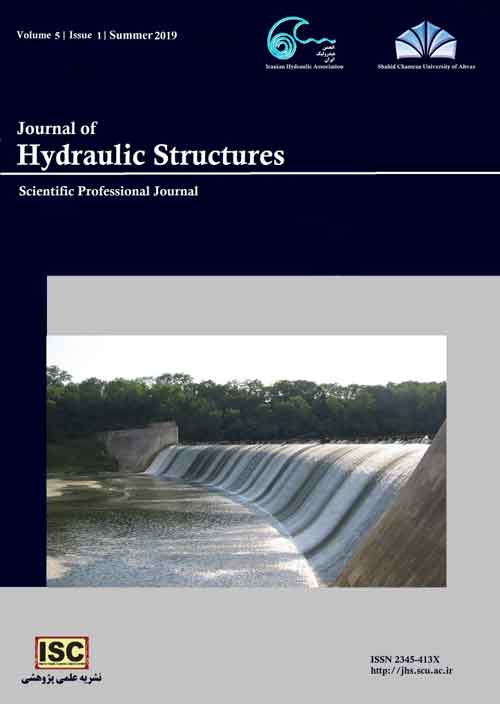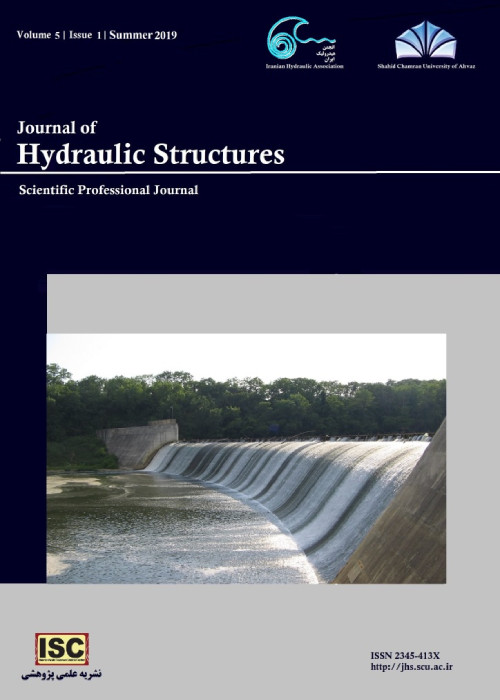فهرست مطالب

Journal of Hydraulic Structures
Volume:8 Issue: 2, Summer 2022
- تاریخ انتشار: 1401/08/10
- تعداد عناوین: 6
-
-
Pages 1-13Phenols are considered serious contaminants because even at low concentrations, they are toxic and characteristics due to their toxic and carcinogenic properties. Removing the phenols from industrial effluents water before entering a stream is highly recommended Ni/ZIF-8 was used in a batch process to adsorb phenol from aqueous solutions at different temperatures. The operating conditions were considered as temperature, contact time, and initial pollutant concentration. The adsorption isotherms at different temperatures were determined based on three different models. For temperature range 25–40 oC, the best-fitting adsorption isotherm models were Freundlich > Langmiur > Temkin. It was found that the Langmuir model fits the experimental data well, with maximum adsorption capacities of 36.8 mg/g at 25, 25.9 mg/g at 40 and 22.4 mg/g at 60 °C. According to the results of thermodynamic analysis, the adsorption of phenol onto zeolite is physical and exothermic. The Ni/ZIF-8 adsorbent proved to be effective in removing phenol by adsorption.Keywords: Phenol removal, MOF, Adsorption Isotherm, Adsorption Capacity
-
Pages 14-26In this study, a novel hybrid treatment system was designed to increase the removal efficiency of petroleum refinery wastewater. The hybrid system is a pilot scale including an activated sludge combined with a rotating biological contractor (RBC) and sand filter. Four vertical rotating polyurethane disks in the aeration tank combined activated sludge-rotating biological contactor pilot. The influent wastewater for this system was the effluent from the DAF unit in the Shahid Tondgooyan Oil Refining Co's wastewater treatment plant. The rotation rate of disks and retention time has been evaluated for their impact on the removal efficiency of total dissolved solids (TDS), dissolved oxygen (DO), pH, total suspended solids (TSS), turbidity (TU), chemical oxygen demand (COD), biochemical oxygen demand (BOD), ammonia (NH3). According to the results, enhancing the rotational speed of disks (from 4 rpm to 8 rpm) and increasing the retention time (from 6 hours to 10 hours) can improve COD, NH3, TSS, BOD5, TU, TDS, and oil removal efficiency of this system to 100, 98.52, 84.21, 100, 99.25, 13.32 and 100% respectively. Escalating the rotational speed beyond 8 rpm had reverse effects on the performance of this hybrid system. The rotational speed of 8 rpm and a retention time of 10 hours were the optimum conditions for removing the abovementioned parameters. It is worth mentioning that the high TU removal efficiency of the system was due to the presence of a sand filter. This system performed well in removing pollutants compared to other biological wastewater treatment systems.Keywords: Petroleum Refinery Wastewater, Rotating Biological Contractor, Activated Sludge, Sand Filter
-
Pages 27-39This study investigates particle breakage and cracks propagation of non-homogeneous rockfill materials, particularly conglomerates, from a microscale perspective. The conglomerate's materials were gathered from Masjed-E-Soleyman, MES, rockfill dam, Iran. The study of particle breakage in rockfill material has been investigated by several researchers worldwide, both in the laboratory and through numerical simulations. However, the previous research focused on homogeneous rockfill materials, not non-homogeneous ones. The first part of this research investigates crack propagation in conglomerates due to high-stress conditions in a rockfill dam. The second part of the paper evaluates the effects of crack propagation on the MES dam crest settlement. In this paper, the microstructure of conglomerates rockfill was determined by performing a set of XRD analyses. The results revealed that calcite constitutes the majority of the rockfill structure. In accordance with geology science, the calcite has a high potential for breaking, and a numerical simulation was developed to illustrate the fractures and crack propagation in a rockfill dam of 177m in height. The results of this research are useful for understanding the concept of large deformations that occurred in the MES dam and needed rehabilitation measures for preventing dam breakage.Keywords: Crack Propagation, Conglomerates, Particle breakage, Stress concentration, Rockfill dam
-
Pages 40-51The planning of sustainable stormwater infrastructures for future water-sensitive cities requires new holistic methods. In the Indo-German research project SMART&WISE, a structured approach was de-veloped to improve the planning processes for water infrastructure systems. The developed approach attempts to map the entire decision-making process when planning suitable infrastructures. A basic distinction is made between retrofit and greenfield planning. Four analyses form the basis of the planning approach: (1) Flood Protection, (2) Water Balance, (3) Water Scarcity and (4) Heat Islands. An indexation of different analyses results enables to overlay and visualize the overall result. The approach was tested successfully in two pilot projects: An Indian pilot case in a semi-arid climate zone and a German pilot case in an arid climate zone. It could be shown that the approach is suitable to cope with heterogeneous population and settlement development, climate change and increasing resource scarcity. The approach can help to facilitate interdisciplinary collaborations (especially urban planners and engineers for urban drainage). Increase in evaporation and a decrease in heat is the decisive advantage of low impact development measures (LIDs) for a sustainable stormwater management. However, an increase in evapotranspiration is not recommended in semi-arid or arid regions, since it would further increase water stress. For regions at risk of water scarcity, a balance between water sources, storage, reuse, and demand must be achieved.Keywords: Sustainable Stormwater Management, Water balance, Heat Islands, Flood Protection, Water Scarcity
-
Pages 52-67
Mountainous areas are highly exposed to storm rainfalls due to the climate conditions in these regions. The current study mainly aimed to identify the channels and potential regions for inundation and flooding in Ardabil, a mountainous city in Iran, using molding capabilities of the SWMM software. Additionally, the functionality of low-impact development (LID) techniques in decreasing the floods of urban mountainous areas (Ardabil city) was investigated. In this research, the existing conditions in the study area, including the region’s slope, the dimensions of the surface run-off collection channels, and the surface water disposal method, were evaluated by reviewing the existing reports and conducting field visits. To calibrate and validate the SWMM model outputs, the amount of rainfall and run-off height within the channels settled in the basin were field-measured during two storm rainfall events. In the current research, green roof, porous asphalt, infiltration trench, and rain barrel scenarios were applied as the LID techniques. In the section of single scenarios, a green roof was the most effective one reducing the run-off by 12%. In the combination of green roof and porous asphalt scenarios, the run-off water volume dropped by 19%. Finally, by combining all the LID techniques, a 30% decrease in the run-off volume was observed. This study also revealed that the use of LID techniques in combining scenarios is superior to the application of single scenarios. Meanwhile, a combination of two scenarios is preferred owing to the ease of implementation.
Keywords: Urban flood management, Surface run-off, Run-off management, SWMM, Low impact development techniques -
Pages 68-83In this study, the laboratory design and construction including: hydraulic, structure and water circulation system of a model for free surface vortex studies at intakes are described in details. Design parameters are considered based on the intake diameter (D) and Froude number (Fr). In order to avoid the scale effects due to the effect of viscosity (υ) and surface tension (σ) in vortex modelling, most criteria are extracted and considered from the previous experimental studies. In structural design of the reservoir and other its components, both stability and construction costs were considered. In order to provide proper visual observation, lighting and imaging; as far as possible, the walls and floor of the reservoir were made of 10mm thick glass. The water circulation system including energy dissipater balls, separator wall, horizontal and vertical intake, butterfly valve, pipe, bend, multiple branch pipe, expansions and contractions, inverter, pump and electromotor, allows formation of vortices at different flow rates and depths and also can keep the water surface at a certain depth. Finally, by considering all design parameters, a rectangular tank with width of 1300mm, length of 2000mm and height of 1500mm was constructed.Keywords: Free Surface Vortex, Experimental model, Intake, Hydraulic, Structural design, Water Circulation System


